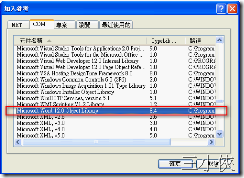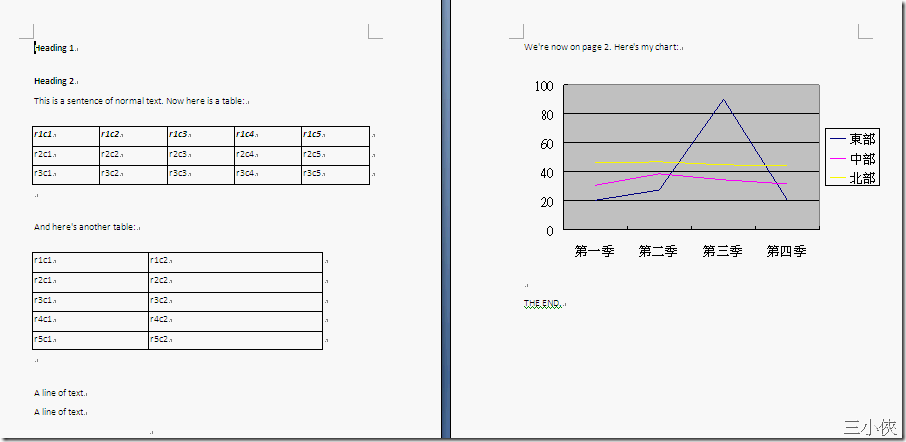[Visual Basic 2003~2005 開發秘訣與範例大全] 筆記(一) 自動化 Microsoft Word 並建立文件
在書上看到這個範例時,感覺很酷,於是起了個念頭想改寫成 C# 版。
在上網搜尋 microsoft word 12.0 object library 的時候,不小心發現 這篇,拿來測試的一下,加入一些註解與 表格 style 的設定。
環境:xp sp3 + vs2008 + .net Framework 3.5 + office 2007
首先專案中需要加入 COM 元件參考(這邊我電腦安裝的是 office 2007):Microsoft Word 12.0 Object Library
程式碼中 using 相關命名空間
using Word = Microsoft.Office.Interop.Word;//設定別名
using System.Reflection;
撰寫程式碼:
object oMissing = System.Reflection.Missing.Value;
object oEndOfDoc = "\\endofdoc"; /* \endofdoc is a predefined bookmark */ //\endofdoc 是一個事先定義的書籤。
//Start Word and create a new document.
Word._Application oWord;
Word._Document oDoc;
oWord = new Word.Application(); //啟動 Word
oWord.Visible = true;
//開新檔案
oDoc = oWord.Documents.Add(ref oMissing, ref oMissing,
ref oMissing, ref oMissing);
//Insert a paragraph at the beginning of the document.
//在文件的開頭處插入一個段落。
Word.Paragraph oPara1;
oPara1 = oDoc.Content.Paragraphs.Add(ref oMissing);
oPara1.Range.Text = "Heading 1";
oPara1.Range.Font.Bold = 1;
oPara1.Format.SpaceAfter = 24; //24 pt spacing after paragraph.//在段落之後 24 pt 空格
oPara1.Range.InsertParagraphAfter();
//Insert a paragraph at the end of the document.
// ' 在文件的尾端插入一個段落。
Word.Paragraph oPara2;
object oRng = oDoc.Bookmarks.get_Item(ref oEndOfDoc).Range;
oPara2 = oDoc.Content.Paragraphs.Add(ref oRng);
oPara2.Range.Text = "Heading 2";
oPara2.Format.SpaceAfter = 6;
oPara2.Range.InsertParagraphAfter();
//Insert another paragraph.
//插入另外一個段落。
Word.Paragraph oPara3;
oRng = oDoc.Bookmarks.get_Item(ref oEndOfDoc).Range;
oPara3 = oDoc.Content.Paragraphs.Add(ref oRng);
oPara3.Range.Text = "This is a sentence of normal text. Now here is a table:";
oPara3.Range.Font.Bold = 0;
oPara3.Format.SpaceAfter = 24;
oPara3.Range.InsertParagraphAfter();
//Insert a 3 x 5 table, fill it with data, and make the first row
//bold and italic.
//插入一個 3 x 5 的表格,填入資料,然後使第一行的表格成為粗體與斜體。
Word.Table oTable;
Word.Range wrdRng = oDoc.Bookmarks.get_Item(ref oEndOfDoc).Range;
oTable = oDoc.Tables.Add(wrdRng, 3, 5, ref oMissing, ref oMissing);
oTable.Range.ParagraphFormat.SpaceAfter = 6.0f;
int r, c;
string strText;
for (r = 1; r <= 3; r++)
for (c = 1; c <= 5; c++) {
strText = "r" + r + "c" + c;
oTable.Cell(r, c).Range.Text = strText;
//Set Style
oTable.Cell(r, c).Borders[Microsoft.Office.Interop.Word.WdBorderType.wdBorderBottom].LineStyle = Microsoft.Office.Interop.Word.WdLineStyle.wdLineStyleSingle;
oTable.Cell(r, c).Borders[Microsoft.Office.Interop.Word.WdBorderType.wdBorderBottom].LineWidth = Microsoft.Office.Interop.Word.WdLineWidth.wdLineWidth025pt;
oTable.Cell(r, c).Borders[Microsoft.Office.Interop.Word.WdBorderType.wdBorderLeft].LineStyle = Microsoft.Office.Interop.Word.WdLineStyle.wdLineStyleSingle;
oTable.Cell(r, c).Borders[Microsoft.Office.Interop.Word.WdBorderType.wdBorderLeft].LineWidth = Microsoft.Office.Interop.Word.WdLineWidth.wdLineWidth025pt;
oTable.Cell(r, c).Borders[Microsoft.Office.Interop.Word.WdBorderType.wdBorderRight].LineStyle = Microsoft.Office.Interop.Word.WdLineStyle.wdLineStyleSingle;
oTable.Cell(r, c).Borders[Microsoft.Office.Interop.Word.WdBorderType.wdBorderRight].LineWidth = Microsoft.Office.Interop.Word.WdLineWidth.wdLineWidth025pt;
oTable.Cell(r, c).Borders[Microsoft.Office.Interop.Word.WdBorderType.wdBorderTop].LineStyle = Microsoft.Office.Interop.Word.WdLineStyle.wdLineStyleSingle;
oTable.Cell(r, c).Borders[Microsoft.Office.Interop.Word.WdBorderType.wdBorderTop].LineWidth = Microsoft.Office.Interop.Word.WdLineWidth.wdLineWidth025pt;
}
oTable.Rows[1].Range.Font.Bold = 1;
oTable.Rows[1].Range.Font.Italic = 1;
//Add some text after the table.
//在表格之後新增一些文字。
Word.Paragraph oPara4;
oRng = oDoc.Bookmarks.get_Item(ref oEndOfDoc).Range;
oPara4 = oDoc.Content.Paragraphs.Add(ref oRng);
oPara4.Range.InsertParagraphBefore();
oPara4.Range.Text = "And here's another table:";
oPara4.Format.SpaceAfter = 24;
oPara4.Range.InsertParagraphAfter();
//Insert a 5 x 2 table, fill it with data, and change the column widths.
//插入一個 5 x 2 的表格,填入一些文字,並更改欄寬度。
wrdRng = oDoc.Bookmarks.get_Item(ref oEndOfDoc).Range;
oTable = oDoc.Tables.Add(wrdRng, 5, 2, ref oMissing, ref oMissing);
oTable.Range.ParagraphFormat.SpaceAfter = 6;
for (r = 1; r <= 5; r++)
for (c = 1; c <= 2; c++) {
strText = "r" + r + "c" + c;
oTable.Cell(r, c).Range.Text = strText;
//Set Style
oTable.Cell(r, c).Borders[Microsoft.Office.Interop.Word.WdBorderType.wdBorderBottom].LineStyle = Microsoft.Office.Interop.Word.WdLineStyle.wdLineStyleSingle;
oTable.Cell(r, c).Borders[Microsoft.Office.Interop.Word.WdBorderType.wdBorderBottom].LineWidth = Microsoft.Office.Interop.Word.WdLineWidth.wdLineWidth025pt;
oTable.Cell(r, c).Borders[Microsoft.Office.Interop.Word.WdBorderType.wdBorderLeft].LineStyle = Microsoft.Office.Interop.Word.WdLineStyle.wdLineStyleSingle;
oTable.Cell(r, c).Borders[Microsoft.Office.Interop.Word.WdBorderType.wdBorderLeft].LineWidth = Microsoft.Office.Interop.Word.WdLineWidth.wdLineWidth025pt;
oTable.Cell(r, c).Borders[Microsoft.Office.Interop.Word.WdBorderType.wdBorderRight].LineStyle = Microsoft.Office.Interop.Word.WdLineStyle.wdLineStyleSingle;
oTable.Cell(r, c).Borders[Microsoft.Office.Interop.Word.WdBorderType.wdBorderRight].LineWidth = Microsoft.Office.Interop.Word.WdLineWidth.wdLineWidth025pt;
oTable.Cell(r, c).Borders[Microsoft.Office.Interop.Word.WdBorderType.wdBorderTop].LineStyle = Microsoft.Office.Interop.Word.WdLineStyle.wdLineStyleSingle;
oTable.Cell(r, c).Borders[Microsoft.Office.Interop.Word.WdBorderType.wdBorderTop].LineWidth = Microsoft.Office.Interop.Word.WdLineWidth.wdLineWidth025pt;
}
oTable.Columns[1].Width = oWord.InchesToPoints(2); //Change width of columns 1 & 2 //更改欄 1 與 2 的寬度。
oTable.Columns[2].Width = oWord.InchesToPoints(3);
//Keep inserting text. When you get to 7 inches from top of the
//document, insert a hard page break.
//繼續插入文字。當您距離文字頂端 7 英吋時,插入一個硬式頁分隔。
object oPos;
double dPos = oWord.InchesToPoints(7);
oDoc.Bookmarks.get_Item(ref oEndOfDoc).Range.InsertParagraphAfter();
do {
wrdRng = oDoc.Bookmarks.get_Item(ref oEndOfDoc).Range;
wrdRng.ParagraphFormat.SpaceAfter = 6;
wrdRng.InsertAfter("A line of text");
wrdRng.InsertParagraphAfter();
oPos = wrdRng.get_Information
(Word.WdInformation.wdVerticalPositionRelativeToPage);
}
while (dPos >= Convert.ToDouble(oPos));
object oCollapseEnd = Word.WdCollapseDirection.wdCollapseEnd;
object oPageBreak = Word.WdBreakType.wdPageBreak;
wrdRng.Collapse(ref oCollapseEnd);
wrdRng.InsertBreak(ref oPageBreak);
wrdRng.Collapse(ref oCollapseEnd);
wrdRng.InsertAfter("We're now on page 2. Here's my chart:");
wrdRng.InsertParagraphAfter();
//Insert a chart.
// 插入一個圖表並變更圖表。
Word.InlineShape oShape;
object oClassType = "MSGraph.Chart.8";
wrdRng = oDoc.Bookmarks.get_Item(ref oEndOfDoc).Range;
oShape = wrdRng.InlineShapes.AddOLEObject(ref oClassType, ref oMissing,
ref oMissing, ref oMissing, ref oMissing,
ref oMissing, ref oMissing, ref oMissing);
//Demonstrate use of late bound oChart and oChartApp objects to
//manipulate the chart object with MSGraph.
object oChart;
object oChartApp;
oChart = oShape.OLEFormat.Object;
oChartApp = oChart.GetType().InvokeMember("Application",
BindingFlags.GetProperty, null, oChart, null);
//Change the chart type to Line.
object[] Parameters = new Object[1];
Parameters[0] = 4; //xlLine = 4
oChart.GetType().InvokeMember("ChartType", BindingFlags.SetProperty,
null, oChart, Parameters);
//Update the chart image and quit MSGraph.
oChartApp.GetType().InvokeMember("Update",
BindingFlags.InvokeMethod, null, oChartApp, null);
oChartApp.GetType().InvokeMember("Quit",
BindingFlags.InvokeMethod, null, oChartApp, null);
//... If desired, you can proceed from here using the Microsoft Graph
//Object model on the oChart and oChartApp objects to make additional
//changes to the chart.
//Set the width of the chart.
oShape.Width = oWord.InchesToPoints(6.25f);
oShape.Height = oWord.InchesToPoints(3.57f);
//Add text after the chart.
//在圖表之後加入文字。
wrdRng = oDoc.Bookmarks.get_Item(ref oEndOfDoc).Range;
wrdRng.InsertParagraphAfter();
wrdRng.InsertAfter("THE END.");
//Close this form.
//' 完成所有作業,關閉此表單。
this.Close();
Application.Exit();
執行結果
程式碼下載:TestOfficeWord.rar
三小俠 小弟獻醜,歡迎指教


